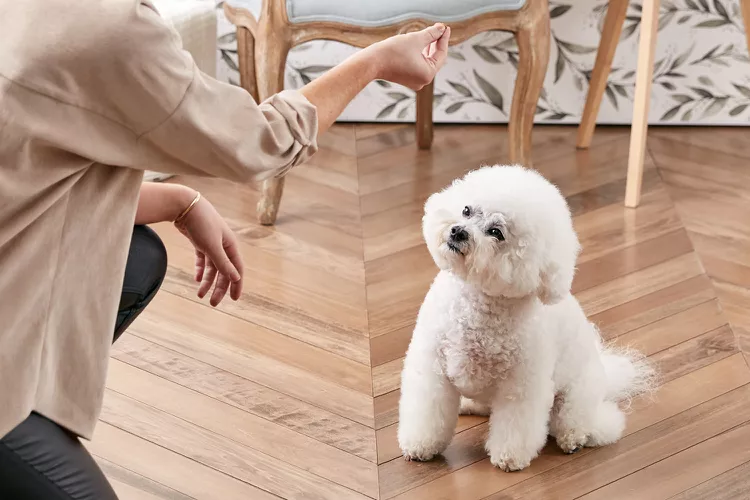Teaching the "sit" command to your dog is usually quite simple, as dogs tend to sit naturally. "Sit" is an important basic dog training command that every dog should know. It is a way to help your dog settle a little bit in one place and focus on you. The training can also help lay the groundwork for "stay" and other more complicated commands. The key is for your dog to associate the word with the action.
Before you begin, make sure you have training treats to offer your dog. These treats should be soft, small, and highly appealing to your dog. If you use clicker training with your dog, have your clicker in hand. Chose a training location that is private and free of distractions, such as your backyard or a quiet park.
Watch Now: How to Train Your Dog to Sit
Know the Proper Sit Position
When your dog is in the correct sitting position, its hocks and bottom are firmly planted on the ground. Some dogs will cheat and "hover" above the ground a little, so be sure not to reward until its rear end is on the ground. Ideally, your dog will remain sitting until you release it (some trainers use the word "OK" as a release cue), but sometimes this behavior doesn't come until the dog has learned "stay." Plan to set aside 5 to 10 minutes a few times a week to work on this training.
Show the Treat
Get your dog’s attention and show your dog that you have a treat in your hand. Hold the treat just above your dog’s nose (not too high or your dog might jump). Move the treat back toward your dog’s ears, keeping it close to the head. Your dog's nose might turn up to follow the treat at first, but most dogs will sit when the treat gets to a certain point. As soon as your dog’s rear lands on the ground, say "yes!" or “good dog” in an upbeat tone (or, click your clicker). Immediately give your dog the treat followed by petting and praising.
Repeat With Cue Word
Repeat these steps until your dog sits at the sight of the treat above its nose. Next, add the cue word: Say your dog’s name followed by the word “sit,” spoken clearly while holding the treat in the position as before. Repeat several times, using the word "sit" each time and gradually phasing out the hand motion (keep using the treat, just phase out the motion).
Continue to Practice
Hold short training sessions throughout the day in various locations, both indoors and outdoors. This will naturally increase the distractions, but you want your dog to sit with any distractions present. End training session on a positive note (with a success). Be patient and consistent.
Problems and Proofing Behavior
If your dog does not sit on its own after a few tries, avoid pushing it into a sitting position. Dogs don't tend to learn well that way. Also, avoid yelling or punishment. Dogs rarely respond to negative reinforcement with anything but confusion. Instead, consider trying more valuable treats, like fresh meat, hot dog pieces, string cheese, or liverwurst.
If you are still having trouble getting your dog to sit with valuable treats, consider marking the behavior. Spend some time watching your dog. Anytime your dog naturally sits, praise and reward it, saying the word "sit." Try this every time you see your dog sitting. You'll want to carry treats with you at all times to make this work well. In addition, it's fairly easy to capture behaviors with a clicker. Once your dog knows how to sit on cue, work on training the sit command in various locations with varying levels of distractions. This is called proofing the behavior and ensures that your dog will be able to obey this command wherever and whenever it's given.

